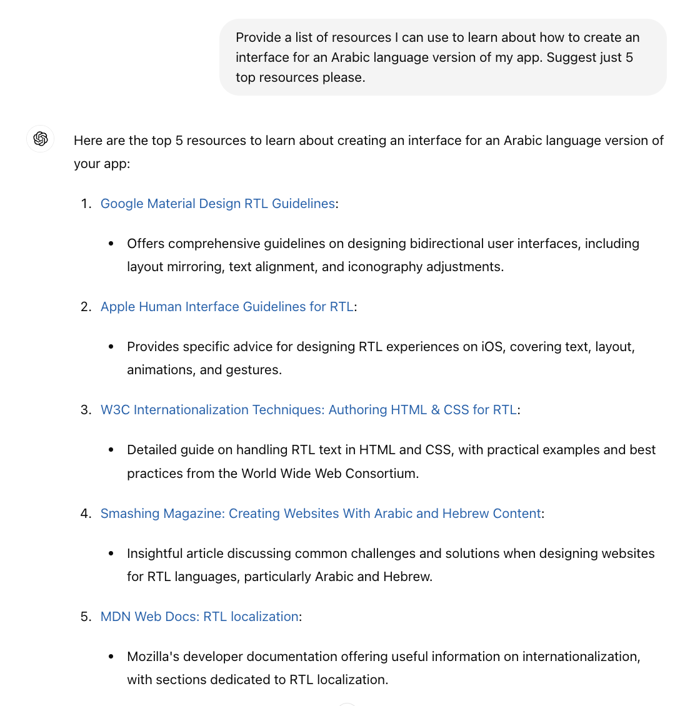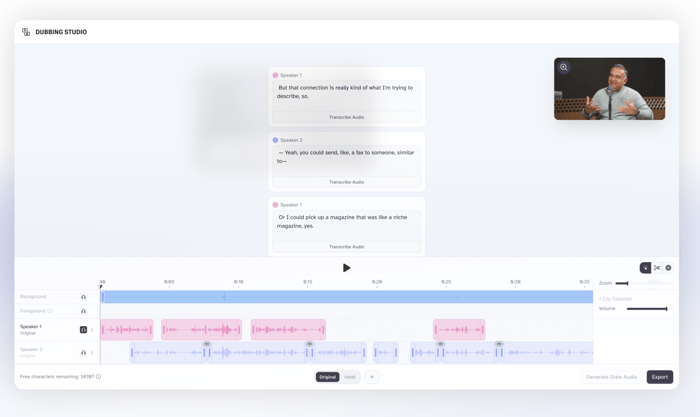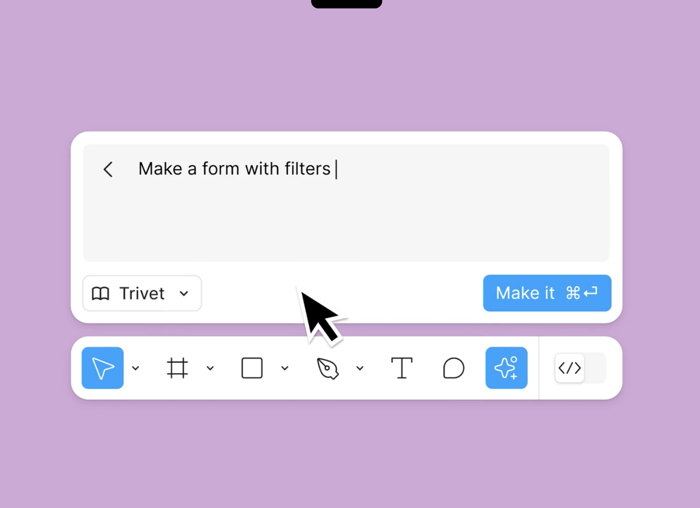Enhancing Design Efficiency with AI Design Tools

But the question everyone asks is – how many of them genuinely support designers in their work? To find the answer, we put 31 AI design tools to the test at Netguru. We considered not only their fit-for-purpose, but also if they meet regulatory and security requirements. Only five of them ticked all three boxes.
The role of AI in design – how design teams use AI
Automation and optimization
AI-powered models automate repetitive tasks and support complex processes. For this purpose, they turn to machine learning (ML), deep learning, natural language processing (NLP), and computer vision.
By handling tedious tasks, AI frees up designers to focus on creativity. For example, creative AI tools for design can quickly make many layout options for websites, or printed materials, following set rules and design principles. This eliminates starting from scratch each time.
Additionally, artificial intelligence can automatically resize and adjust designs for different formats and devices, ensuring consistency and reducing manual work.
AI speeds up some complex design processes by using predictive analytics to spot trends in user data, helping designers create more relevant designs. It also automates A/B testing by analyzing user interactions with different designs, providing insights into which elements perform best.
AI design tools can generate diverse variations from the designer's rules, leading to unexpected and creative solutions. They also learn from various design styles and elements, combining them uniquely.
Available AI design tools and technologies
There are three concerns that make us very selective at Netguru when it comes to using AI design software:
- Overpromising the value of their solution in the design process
- Privacy issues
- Security concerns.
While there are a few helpful tools out there, I believe that a true design revolution hasn't occurred yet. Our team only currently approves about half-a-dozen AI design tools for internal use, which I discuss in detail in the next section.
Here are a few categories of AI design software tools currently available on the market:
- AI Design Assistants which help generate mock-ups and UI designs from text, screenshots, or hand-drawn wireframes (e.g. Uizard).
- AI Site Builders which build websites by generating content and layouts (e.g. Relume and Dora AI)
- UI Generation platforms which focus on quickly creating and visualizing UI designs (e.g. Galileo AI)
- Custom code generators for web development which produce custom code (e.g. Slater AI)
- 3D design tools which specialize in creating 3D designs (such as Spline AI)
- AI interview and analysis tools which perform AI-powered interviews and analysis or take notes during meetings (e.g. Tellet and Grain)
- Color palette generators which use artificial intelligence to create color palettes (e.g. Khroma)
- Writing assistants which help brainstorm ideas for UX writing (e.g. lCopy.ai)
- AI user research tools which assist in conducting and analyzing research (e.g. Maze AI)
- AI-Powered Figma Plugins that aid in various design tasks, including generating wireframes and content (e.g. WireGen, Wireframe Designer, and LoremGenie)
- Finally, design to code tools which convert design files into code (e.g. like Locofy, Builder.io, and Figma).
AI design tools in Netguru
From all the above, we approved and currently recommend these five AI powered tools, as they not only aid our designers but also meet our security and legal standards.
Perplexity for desk research
Perplexity is a free AI assistant which can help designers find answers to their questions. Think of it as a conversational AI-powered search engine that merges natural language processing with real-time web-search capabilities.
Among others, it can proofread copy, participate in brainstorming sessions, or break down milestones into smaller tasks. It also has analytical capabilities, which means you can provide it with your design problems and ask it to suggest multiple solutions. This tool can also be useful if you have an international team, as it can translate copy into other languages.
Some other ways this tool can help include asking it to create storylines for characters in your project, or ideas on how to unify disparate design elements. While doing this, Perplexity can source interesting facts and information online to give designers a broader market context.
Tellet for interviews
Tellet is an AI platform for interviewing and studying consumer behavior. It can manage hundreds of concurrent interviews. People can respond verbally, by video, or using photos. The AI asks follow-up questions, too.
Tellet allows for instant analysis of information, highlighting key themes, patterns, and suggestions for easier understanding of responses.
ChatGPT for ideation and creating summaries
There are many iterations or versions of ChatGPT. You can choose the best fit for your needs. Like Perplexity (above), it can participate in brainstorming sessions, using its vast training-data stores to understand your idea and compare it to variations from elsewhere. It can then evolve a new application combining features of several to make something unique.
You can change ChatGPT’s viewpoint, looking at it from the buyers’, sellers’, or users’ perspective, summarizing each. This generates insights allowing you to change your presentation to make it more attractive/effective to each audience. It also conducts research to enhance accuracy and generate new ideas for your project.

ChatGPT can recommend relevant resources on new topics, and suggest media elements to include
ChatGPT shines at making short summaries out of long texts. It saves our designers’ time by quickly explaining the main points of documents, articles, or research papers. This helps everyone who needs to understand complicated information. Whether you're summarizing reports, articles, or books, ChatGPT helps you get the most important details without extra effort.
Midjourney for teasers
Midjourney is an AI design generator that can create high-quality visuals of product ideas that designers use for impressive teasers. These provide potential designs before the actual product is made. At Netguru, we use Midjourney to help clients decide whether they want to work with us – if they express interest in potential cooperation, we create a “teaser” design to show them what to expect.
Using Midjourney speeds up the design process – some UX specialists say it can make prototyping and idea generation even ten times faster. You can quickly generate a selection of 20 different prototypes for client review – a task that would otherwise require significantly more time if done manually.
Eleven Labs for client presentations
Eleven Labs helps the design team at Netguru create voice simulations that are indistinguishable from real humans. You can provide text input and listen to it in different voices, which vary by sex, age, and accent. This comes in handy especially when we’re designing interfaces for audiences belonging to specific ethnic groups. The voice generator makes the product sound "local", shortening the distance between the brand and end user.

Eleven Labs as the AI design tool we recommend using
Our design team doesn’t use it only for live products, though. We also turn to it when creating presentations for new or prospective clients.
Tool with a lot of potential: Figma for prototyping
On top of the five tools we use at Netguru, I’ve decided to add Figma here as an “honorary mention” of sorts. While its large-scale AI tools are still being rolled out and I can’t vouch for them, it has some interesting new features coming out. I recommend fellow designers to give them a try, as they’ll be entirely free during beta-testing.
The AI powered features include the ability to intelligently rewrite your text, logically auto-name (for example) “Frame 5819791980 ” to “Inputs and CTAs”, or rename items on a “as needed” basis.

Figma as an AI design tool worth trying to speed up prototyping
According to Figma, it won’t stop there. They say that you’ll be able to search for assets in your library with an image and turn your static mock-ups into interactive prototypes. If this is true, then handing this tedious “connection process” to the AI will leave you much more time for your main work, i.e., design.
Challenges
Technical challenges
Incorporating AI into graphic design presents several technical hurdles. These include mastering new software and troubleshooting glitches. Another key aspect is ensuring smooth integration with existing workflows across various AI platforms.The whole process can be quite daunting.
Keeping up with the latest AI advancements and exploring the intersection of graphic design and AI is a continuous journey for me.
I suggest that you be prepared to tackle compatibility issues, learn new tools, and ensure your hardware can handle the demands of AI applications. Additionally, be ready for the possibility that AI outputs may not always match your exact vision, and you’ll have to apply adjustments for optimal results.
Adoption barriers
Confidence
New designers may feel uncertain about using AI tools initially. While these tools are intuitive after some practice, the specialized jargon can be daunting at the beginning.
This knowledge gap also poses a top-down barrier for teams eager to adopt AI. According to IBM’s Global AI Adoption Index, the most frequently cited barrier to adoption among executives was limited AI skills and expertise.
Ethics
Who does the AI output really belong to…the organization that trained the AI? You for asking the right questions, or the source for the original information?
Say that an AI generator makes an image for you, which is a composite of all the data that went into its training. Can someone claim ownership because one of their images was used in the training?
This legal gray area will persist for years until we arrive at official policy. No matter how much effort the teams behind the most popular and advanced large language models (LLMs) put in, these concerns will persist to some extent.
Cost of implementation
Budget constraints might limit access to cutting-edge AI technologies. Bear in mind that a lot of SaaS tools – AI design software included – offer a specific number of credits each month. For example, your plan might let you create 10 or 15 AI generated designs. If you run out of credits before you get your work done, then you’ll have no other option but to upgrade to a higher plan.
This could be a real challenge if your organization doesn’t have the same budget to invest in AI integration as your competitors. Creative solutions, such as using open-source tools can help mitigate some of these expenses.
Resistance to change
Some people may be rooted in their methods and hard-pressed to adopt new methodologies and tools to incorporate AI. They may also fear losing jobs despite the likelihood of creating more jobs.
AI tools for designers are the future of effective design
We have tried and tested a lot of AI tools at Netguru. However, when it comes to the design process, there is still a lot of room for improvement. We still need to wait for a revolution. There are tools like Perplexity and Tellet, which come in handy in the discovery phase. However, most AI software out there tends to over promise on its value.
In my opinion, the best way to approach AI-powered design tools is to do it with caution ( it needs to ideally meet your goals and regulatory requirements). Consider implementing them in phases – test out tools for one potential area, and remain rigorous in your requirements. After all, since AI won’t remove human designers any time in the foreseeable future.
-Jul-24-2024-11-04-54-3799-AM.png?width=50&height=50&name=image%20(1)-Jul-24-2024-11-04-54-3799-AM.png)

-Jul-24-2024-11-04-54-3799-AM.png?width=240&height=240&name=image%20(1)-Jul-24-2024-11-04-54-3799-AM.png)





